
The flight back was just as magnificent as the
arrival. Somewhat of an adventure too since we were in rain storms a
couple of times and the pilot was constantly in radio communication
with a colleague in the vicinity to make sure they were not about to
run into each other. It cleared up some before we landed in Ritsem and
this is the last picture we took from the helicopter, looking west over
Vastenjaure coming back.
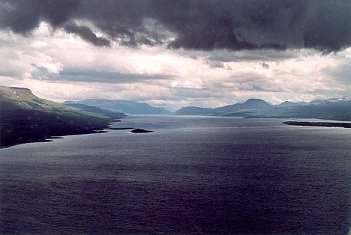
The pictures of Akka were 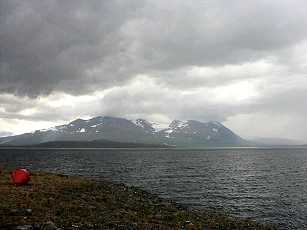 taken after the landing at the
heliport in Ritsem.
taken after the landing at the
heliport in Ritsem.
As was the case with so many other sites, we saw them in such different
weather conditions back in 1950. It seems to have been clear weather
all the time that year. Or could it be that my memory deceives me!?
However, we were told that the peaks of Akka are usually partly covered
in clouds.
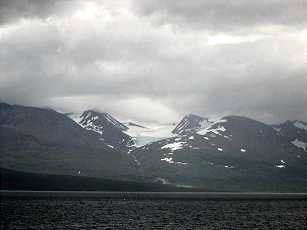 Akka (Stortoppen 2015m,
Borgtoppen 1963m) with Akkajaure in the forground. We are now back on
terra firma and ahead of us is the climb up the hill to Ritsem tourist
station. There is no restaurant
there either, so again, we had misplanned the food detail. ( And again,
they could make it a little easier to climb up to the upper bunkbed
- a little peg to hold on to is all it would take.) The next day,
however, we were
back in Saltoluokta (no breakdowns on the road this time), and it was,
after all, a good feeling to be back in 'civilization', being spoiled
once again by having excellent meals served and hot water showers.
There
is hot water and electricity in Ritsem, but you are totally dependent
on
yourselves for food.
Akka (Stortoppen 2015m,
Borgtoppen 1963m) with Akkajaure in the forground. We are now back on
terra firma and ahead of us is the climb up the hill to Ritsem tourist
station. There is no restaurant
there either, so again, we had misplanned the food detail. ( And again,
they could make it a little easier to climb up to the upper bunkbed
- a little peg to hold on to is all it would take.) The next day,
however, we were
back in Saltoluokta (no breakdowns on the road this time), and it was,
after all, a good feeling to be back in 'civilization', being spoiled
once again by having excellent meals served and hot water showers.
There
is hot water and electricity in Ritsem, but you are totally dependent
on
yourselves for food.
At the little store next door, unfortunately, you can only buy big
packs of everything. But, the same way as in Stalo, people do leave
things behind and it helps a lot. Most of the electric stoves were in
working order and there was even an electric kettle for fast water
heating. Oh, glorious civilization!
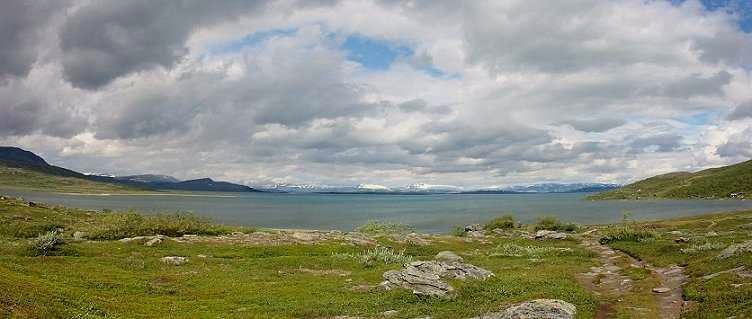

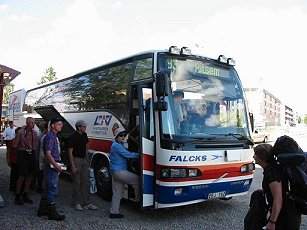 over to the northern
side of Lake Langas where we caught the bus for Ritsem at Kebnats,
which is really just a parking lot and a bus stop.
over to the northern
side of Lake Langas where we caught the bus for Ritsem at Kebnats,
which is really just a parking lot and a bus stop. 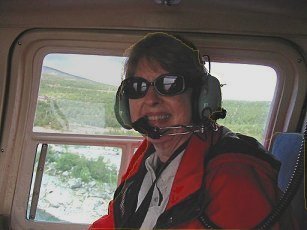
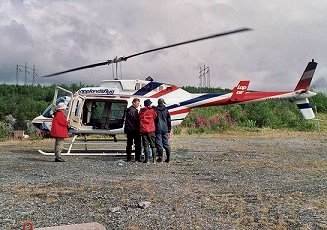
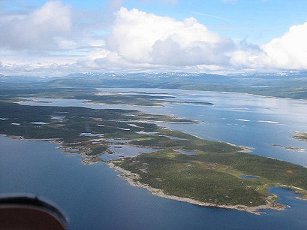 a
swamp and also finally the boat dock - in time for the departure.
There were a couple of other passengers, but certainly no crowd. This
unique boat trip took a few hours and we arrived at Stalo towards the
evening.
a
swamp and also finally the boat dock - in time for the departure.
There were a couple of other passengers, but certainly no crowd. This
unique boat trip took a few hours and we arrived at Stalo towards the
evening. 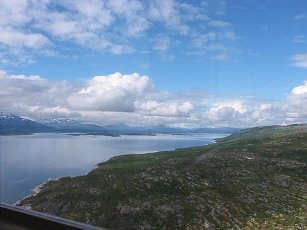
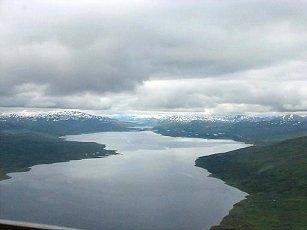 The
snowy mountains over to our right are most likely in Norway.
The
snowy mountains over to our right are most likely in Norway.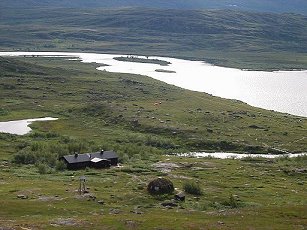 not
getting water after they had used some. Our only small complaint
was that there was not even a peg to hold on to when
climbing up to the higher bunkbed - to lighten the task for the weary
wanderer!
not
getting water after they had used some. Our only small complaint
was that there was not even a peg to hold on to when
climbing up to the higher bunkbed - to lighten the task for the weary
wanderer!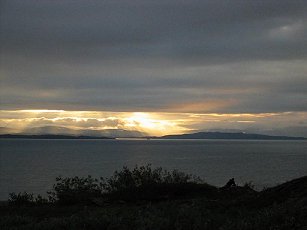
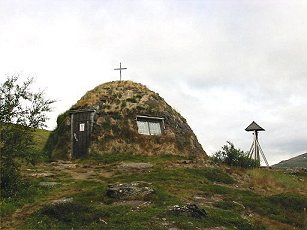 leaving, it was our job to clean the dining room, sweep, wipe off
tables and do whatever else needed doing.
leaving, it was our job to clean the dining room, sweep, wipe off
tables and do whatever else needed doing.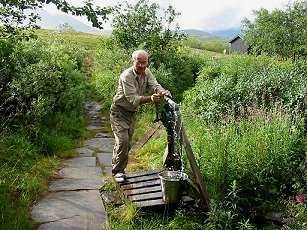 The outhouse was a few hundred
meters away, which seemed a bit unnecessary as far as distance goes,
but there are four spotlessly clean 'heads' - as we say in this family.
The outhouse was a few hundred
meters away, which seemed a bit unnecessary as far as distance goes,
but there are four spotlessly clean 'heads' - as we say in this family.
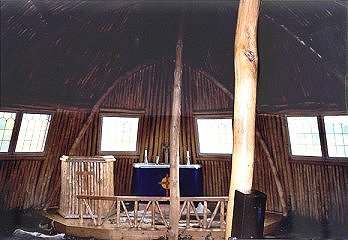
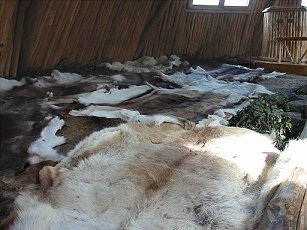 be right, but there is no way you should come to Stalo without bringing
your own provisions. A good breakfast and some vacuum-packed
food for dinners is the most important thing to carry in your backpack.
We now know how to do it right next time. People often
leave things behind that they don't need any more, such as sugar
and powdered milk and obviously you don't have to carry things like
dish soap. But we should at least have brought some oat meal to cook
for breakfast, some tea bags, instant coffee and a few more
essentials. Tunnbröd (thin dry bread, very good, a
Norrland specialty) you can buy
at the kiosk from the Sami family up the hill, but many things
can be carried along in the pack without adding a lot of weight.
be right, but there is no way you should come to Stalo without bringing
your own provisions. A good breakfast and some vacuum-packed
food for dinners is the most important thing to carry in your backpack.
We now know how to do it right next time. People often
leave things behind that they don't need any more, such as sugar
and powdered milk and obviously you don't have to carry things like
dish soap. But we should at least have brought some oat meal to cook
for breakfast, some tea bags, instant coffee and a few more
essentials. Tunnbröd (thin dry bread, very good, a
Norrland specialty) you can buy
at the kiosk from the Sami family up the hill, but many things
can be carried along in the pack without adding a lot of weight.
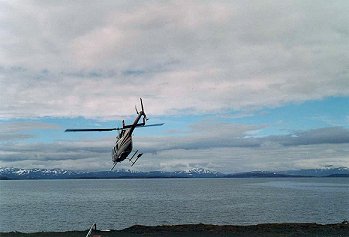
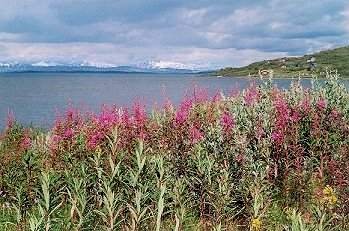 long day's hiking.
Dried fruit and chocolate are good
things to carry along too.
long day's hiking.
Dried fruit and chocolate are good
things to carry along too. 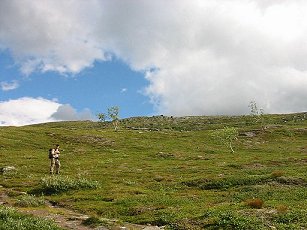 covered by clouds.
covered by clouds. 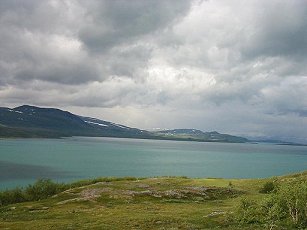 the rain clouds closed in
and finally burst. The colors on the lake were unbelievably beautiful.
I could just have stayed
there and stayed and stayed, admiring the colors on the lightly ruffled
surface of the water and the mysterious mountains in the background,
half covered in mist. We were pretty soaked when we got back, just in
time to have a quick bite, get our things together and
catch the helicopter back to Ritsem.
the rain clouds closed in
and finally burst. The colors on the lake were unbelievably beautiful.
I could just have stayed
there and stayed and stayed, admiring the colors on the lightly ruffled
surface of the water and the mysterious mountains in the background,
half covered in mist. We were pretty soaked when we got back, just in
time to have a quick bite, get our things together and
catch the helicopter back to Ritsem. 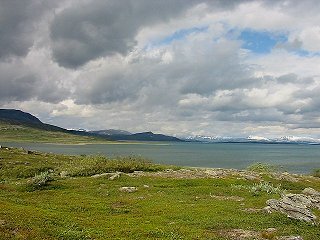


 taken after the landing at the
heliport in Ritsem.
taken after the landing at the
heliport in Ritsem.  Akka (Stortoppen 2015m,
Borgtoppen 1963m) with Akkajaure in the forground. We are now back on
terra firma and ahead of us is the climb up the hill to Ritsem tourist
station. There is no restaurant
there either, so again, we had misplanned the food detail. ( And again,
they could make it a little easier to climb up to the upper bunkbed
- a little peg to hold on to is all it would take.) The next day,
however, we were
back in Saltoluokta (no breakdowns on the road this time), and it was,
after all, a good feeling to be back in 'civilization', being spoiled
once again by having excellent meals served and hot water showers.
There
is hot water and electricity in Ritsem, but you are totally dependent
on
yourselves for food.
Akka (Stortoppen 2015m,
Borgtoppen 1963m) with Akkajaure in the forground. We are now back on
terra firma and ahead of us is the climb up the hill to Ritsem tourist
station. There is no restaurant
there either, so again, we had misplanned the food detail. ( And again,
they could make it a little easier to climb up to the upper bunkbed
- a little peg to hold on to is all it would take.) The next day,
however, we were
back in Saltoluokta (no breakdowns on the road this time), and it was,
after all, a good feeling to be back in 'civilization', being spoiled
once again by having excellent meals served and hot water showers.
There
is hot water and electricity in Ritsem, but you are totally dependent
on
yourselves for food.